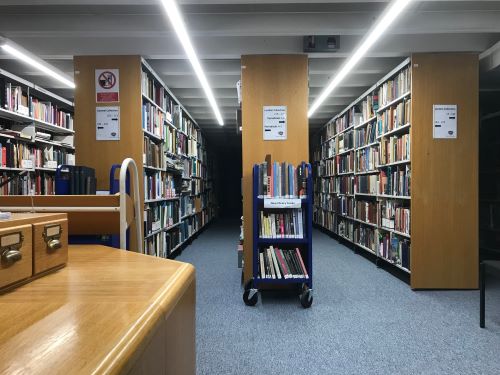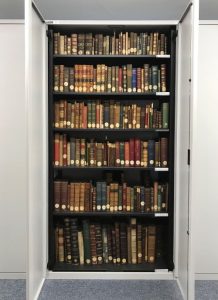Library of the Week: 19th June : London Museum Library! Such an exciting post this week as we chat to Librarian, Lluis Tembleque Teres, to find out more about the amazing collections at the London Museum Library.
Thank you very much for taking part in our Library of the Week! Please could you tell us a bit more about where you work and what your role is?
I am the Librarian at the London Museum, where I run the service as a ‘team of one’. The figure of the ‘solo Librarian’ is relatively common in the museum libraries world, where professionals find themselves constantly spinning many different plates: from acquisitions and subscriptions management, to cataloguing, collections development, service promotion or enquiries, among many other tasks. Solo librarianship however can be very rewarding, with varied days and the possibility to lead on projects and own successes.
Since April 2021, I am also auditing and recataloguing our complete collection in preparation for the move to our new museum. The exercise, expected to last some years, is the perfect opportunity to rationalise our holdings (with work towards deduplication, disposals, classification improvements) and also introduce international book cataloguing standards to our records (RDA, MARC21, Library of Congress Authorities).

What collections do you have? / What does your library specialise in?

A book collection has been part of the London Museum and its predecessors for nearly two hundred years. As the museum, the Library specialises in the history, archaeology and social history of London and its people. To support these subject areas, we also collect volumes about decorative arts, architecture, fashion, museum studies, and conservation, among others. At present, the library collection comprises over 30,000 volumes, including 7,000 items in the Port of London Authority Library (on loan to the museum) and approximately 5,000 in the Special Collections. Highlights include the Bell Collection on the Great Plague and Great Fire; the Tangye Collection of Cromwelliana; the Warwick Wroth Collection of scrapbooks on Vauxhall Gardens and South London Pleasure Gardens; the Harry Matthews Collection of fashion books and periodicals; and the Mary Young Papers, household accounts of an early 19th century middle-class family. The collection also holds over 450 serials dedicated to the abovementioned topics.
As a service, the Library caters mainly for an audience of internal readers, namely museum staff and doctoral students. External access as a last resort, reference-only service via research appointments closed in December 2022 in order to facilitate the collections audit exercise.
What’s your favourite item from the collections? Why? Tell us a bit about it.
Due to historical reasons, our Special Collection are quite eclectic, and often the volumes that less relate to London are the ones with the best stories. For example, we have a medieval early printed book that belonged to the artist William Morris; we also have a copy of a play published by Morris that draws its design directly from the medieval volume. From the Tangye collection, we have Cromwell’s family bible, and a manuscript volume of sermons from the early 15th century believed to have been in Charles I’s library (this is the museum’s oldest book). While we are in the subject of Bibles, the library has a slightly burnt example believed to have just about survived the Great Fire of 1666. We also have three of Emma Hamilton’s music books; they include previously unrecorded songs to Lord Nelson, written by mutual friends to celebrate his victories.
Hidden among library volumes are also interesting stories of ordinary Londoners: pocket books and almanacs include notes on daily activities or household accounts; press cuts collected in scrapbooks show an interests in, for example, recording historical buildings being lost due to the Victorian expansion of the city. Similarly with personal diaries, Frank Halden Macey’s being my favourite. Mr Macey was interested in theatre, was a keen cyclist and also enjoyed painting quick watercolours when travelling around the city. The original 24 volumes, spanning from 1876 to 1942, include dozens of them, beautiful snapshots of life in the capital, from views of the river Thames, St. Paul’s and Hampstead village to many of the London parks and forests.
What’s new and exciting in your library? What have you got coming up?

With a new museum being built, the Library has an opportunity to reinvent its service and institutional presence. With this in mind, work is taking place towards very specifics goals: to make the library more relevant to all museum staff, with better internal promotion; to improve the cataloguing and documentation of the collection; and therefore be able to increase awareness among the broader external research audience by promoting its unique holdings. Joining NBK is a good example of a step towards this latter objective.

In 2023, the Library and the new museum project team are due to look into the design requirements for a Research Room in the museum’s new site, as part of the Poultry Market development. The space is expected to combine the library and the research services. For the first time in the museum’s history, the room will be in a public-facing area of the building. This is a game changer, an opportunity to make the Library an active part of museum life.
Lluis Tembleque Teres – Librarian – London Museum
All images copyright of the London Museum, Secchi Smith and Atelier 78, reproduced with kind permission of the copyright holder.
You can explore the library’s collections on Discover and find further contact details on their Discover information page.
edit – this blogpost was updated on 25/07/24 to change the name ‘Museum of London’ to the ‘London Museum’ due to new name branding.


One reply on “London Museum Library”
Great read. I’m interested in Museum libraries.